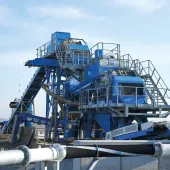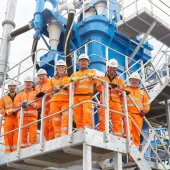New Aggregate Processing Contract at Masters Quarry

First published in the August 2018 issue of Quarry Management as Dorset Sand Masters
DUO Mineral Processing delivering successful long-term processing contract at Hanson UK’s Masters Quarry
Hanson UK’s Masters Quarry is located adjacent to Puddletown Road near the town of Wareham, in Dorset. It was previously worked by Hanson and Holme Sand and Ballast as a single unit between 1987 and 2012, and comprised four extraction areas, Hyde and Hines and Masters North and South, with Hanson operations being mothballed in September 2012.
Masters (or Hyde as it was originally known) is situated in an area of lowland heathland that is internationally recognized as an important habitat for smooth snakes and sand lizards; both the reptiles and their habitat are protected under European Protected Species (EPS) designation.
The land itself was not classified as important until the late 1990s, so prior to this time the quarry worked the underlying sand and removed the heathland in the process. When Hanson UK received notification that the land was to be designated as a cSAC (candidate Special Area of Conservation), in addition to its existing SSSI and SPA designations, extraction was transferred from the Masters North and South areas to freehold land at Hyde Pit, which, having already been stripped prior to the notification of the designation, allowed the quarry to continue working at an output of around
300,000 tonnes per annum.
Planning modification orders preventing the extraction of minerals from undisturbed heathland were formally issued in November 2006, sterilizing approximately 9 million tonnes of reserves. However, most of the minerals affected by the modification orders were located within Masters North and South, and thus the mineral asset was not affected, although the orders significantly reduced the minerals available for future extraction.
Quarry manager Simon Parkes explained: ‘Although never worked as a stand-alone quarry, Hanson planned to reopen Masters Quarry in April 2016 with a fresh team and I was appointed as quarry manager to take the project forward.
‘We had a lot of problems with the EPS, as in this area we have every species of reptile in the UK. Therefore, we had a responsibility to survey and ascertain the number of reptiles, and considering there had been no activity on site since 2012, the numbers were considerable. However, after surveying, applying for a licence, erecting a reptile fence, and capturing and moving animals to a receptor area, this was eventually achieved to the satisfaction of all parties.’
Having cleared the site, a ramp down to the quarry floor had to be constructed from the ground up. Work commenced in October 2016 with the ramp constructed from highway level, at 53m AOD, to the plant site level, at 37m AOD, with the first 50m paved. All infrastructure work, including the plant pad, was completed by Hanson Contracting using asphalt, concrete and roller-compacted concrete (a first for Hanson in this area).
As English and Welsh dealers for Terex Washing Systems (TWS), DUO offer a range of innovative wash plants and water-management solutions, and Hanson, having completed many previous successful projects with the company, once again awarded the mineral-processing contract to DUO’s Minerals Processing Division. The contract is based on a cost-per-tonne basis with the plant supplied being more than capable of achieving 300,000 tonnes per annum. Mr Parkes continued: ‘Through previous contact at other sites, I already had a working relationship with DUO and therefore it was an easy transition to work alongside them again.’
Sand and gravel plant
The material to be processed is predominantly sand with small quantities of gravel on the surface and underlying seams of clay to varying depths. In light of previous processing issues, DUO based their plant design around some of the latest TWS technology – a Terex AggreSand 206 modular wash plant. In addition, due to the presence of lignite on site, a single TAK Hydroclassifier was included in the specification to remove this deleterious element from the fines fraction.
The Terex AggreSand 206 is a pre-wired and pre-plumbed modular concept plant that facilitates quick and easy installation, as well as ease of access and serviceability. The all-electric plant installed at Masters includes a rinsing screen, sand plant, the TAK lignite-removal plant, stockpilers and all associated pipework and electrics on a single modular chassis, with a sizing screen completing the specification.
Mr Parkes commented: ‘It’s a very neat, compact plant incorporating an in-line system that TWS and DUO have had major success with in the market. It’s ideal for the operation at Masters and we have confidence in it delivering our expected production rates.’
Currently operating at 150 tonnes/h, the plant features two ‘side-by-side’ remote-control tipping grids. These are fed by loading shovel via a single ramp. A drier, coarser deposit extracted from Hines Quarry and delivered to Masters is fed on to one grid, with the second receiving the on-site material.
These two materials can be blended as they are fed on to the plant’s primary conveyor for delivery to a 20ft x 6ft triple-deck rinsing screen. Angled at 18°, this two-bearing unit is fitted throughout with polyurethane modular media and utilizes individually controlled spray bars on each deck. The top deck provides protection for the lower decks, removing any oversize material (mainly balls of clay), which are fed to a stockpile via an on-board conveyor, while the middle deck recovers any 6–10mm gravel and smaller balls of clay, which are also conveyed to stockpile. The bottom deck is split at 2mm and 5mm and provides the required feed to produce two sands. All chutes on the AggreSand 206 employ dead-boxes for improved wear characteristics.
The Masters AggreSand 206 is a high-capacity 150 tonnes/h sand plant with a high-energy 4.3m x 1.8m dewatering screen and features one 200/150 pump and 625mm cyclone and one 200/150 pump and 500mm cyclone for the production of clean, in-specification coarse and soft sand respectively. A specially designed rubber-lined underflow box allows blending to take place so that an acceptable coarse and fine sand ratio can be achieved. These sands are delivered to separate radial conveyors for stockpiling.
The plant at Masters also incorporates a TAK Hydroclassifier supplied by DUO’s Spanish partners AMP. Sand is screened through the main washing screen on the AggreSand 206 and fed to the main sand sump, then into the TAK via a hydrocyclone. This removes the ultra-fine particles and delivers a concentration of sand (c.65% solids) into the TAK vessel, whereupon a rising current floats off the lighter particles. With lignite weighing around two-thirds less than sand, this specialized system removes the lightweights and allows precise control of the desired sand grading. Designed specifically for the classification of glass sands, which have very tight tolerances, the TAK Hydroclassifier can be adjusted to deliver a highly defined ‘bottom end’ in the sand.
The control system for the AggreSand 206 wash plant is housed in a centralized cabin, which is one of the options offered by DUO on all TWS AggreSand installations. Alternatively, the panel can be mounted on the machine itself, exemplifying the flexibility of TWS and DUO and the AggreSand concept to suit individual customer needs or preferences.
DUO sales director John Bracken said: ‘DUO and Hanson have a very good working relationship on numerous projects. A lot of thought has gone into this plant and it has been designed in such a way that a log-washer can be incorporated when more gravel-bound material is excavated in the future. Additionally, should it be required, a second TAK Hydroclassifier can also be added to the plant.’








